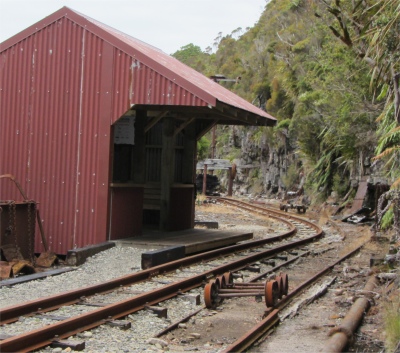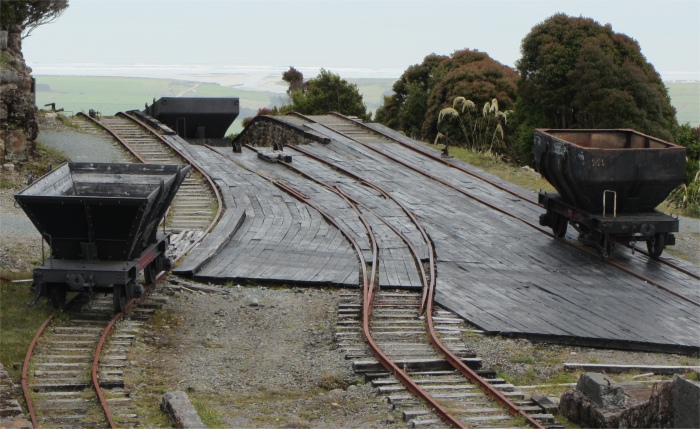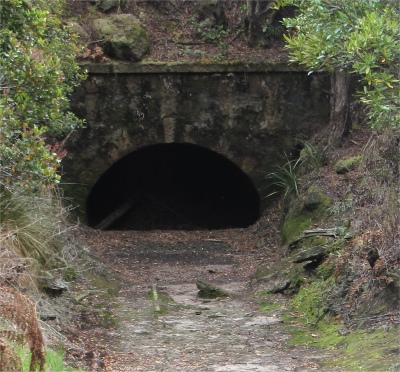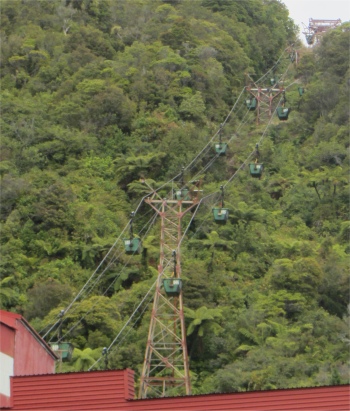 Remnant of Whareatea Aerial Ropeway |
 Remnant of Banbury Rope Road |
Now for the day to begin. 17km north of Westport is the village of Waimangaroa, the gateway to the historic semi-ghost town of Denniston, located 9km away from the coast, and 600metres above sea level with sweeping vistas of Westport and the surrounding landscape.
In 1859 John Rochfort discovered loose pieces of coal in the Waimangaroa River, and in the following year, during an investigation of coal prospects on the West Coast, Julius von Haast and James Burnett located a seam of coal at a locality they named Coalbrookdale.
This discovery led to detailed surveys of the Buller Coalfield, principally by Cooper, Cox and Denniston, and in 1874 the coal resources of the Denniston Plateau were reported as 72 million tons. As the coal resources were located at an elevation of 600m above sea level, their development required an innovative method for transporting the coal down the escarpment to the railhead. Following route surveys, an inclined railway was recommended and construction was completed in 1880: the Denniston Incline.
 Top of the Denniston Incline |
The top of the incline served as a hub for coal from the Banbury, Burnett's Face and Ironbridge mine areas, delivered by surface rope roads, and from the Sullivan, Whareatea and Coalbrookdale mine areas, delivered by aerial ropeway. A small town grew housing incline workers and miners. By 1911, Denniston was New Zealand's largest coal producer, and boasted a population of 1500. Most of the people were from Britain. Goods and people were transported over the incline too, but after a few fatalities, a steep Bridle Path was constructed in 1884. Its arduous and often treacherous access meant that many of the early settlers came down from "The Hill", as they called it, only once a year; some, particularly women, not for a decade or more. Midst the endless tapping of picks, creaking of props and the earthy black soot of ever present coal dust from an 1880s coal mine, a proud and close-knit community formed within this remarkable land of contrasts.
 Looking Down the Steep Incline |
I find the industrial archaeology of such sites fascinating, but equally fascinating was the stories of the men, women and children who lived here. Being so remote they had to be very self-reliant. They soldiered on through their hardships, hung out their washing despite the constant dust in the air, schools were full, and there was plenty of support for the town's football, rugby and hockey teams. The hotel bar was a favourite meeting place after a hard shift; the police station was conveniently located next door.
Display boards gave some interesting accounts from some of the town residents. Frank Robertson wrote:-
"What I remember most are the earthquakes - Murchison and Inangahua especially. I was in the mine for the last one. Everything was shaking. An older experienced man said, "Stand behind a big prop, you'll be alright." I did. Then the flat pieces that jam the props to the roof fell out and my big prop was swaying. The other man took off and I thought - he's the experienced one! I'm running too .... I'm going all the way. I did, but not all the men left the pit."
 Millerton Mine |
The Friends of the Hill Museum nearby brought to life the harsh conditions experienced by the towns folk, and also the lighter moments, through a series of photo albums and calendars featuring black-and-white photographs on them. A roaring coal fire blazed away in the corner, and two old dears sat alongside it, welcoming visitors and chatting about the past history to any who were interested.
 Stockton Aerial Ropeway |
I told her the tale of the jam-eaters, the nickname given to miners from west Cumbria, which she found hilarious, and was already drawing up a list of names she could pass that on to as I waved farewell.
As I drove down the long, winding hill down to sea-level, I passed a clown trying to skateboard down the steep hill. Apart from the dangers of falling off at that speed, all he needed was a car coming up the hill on a blind corner to make his day.
I moved on to Millerton, another hillside mining community some kilometres up the coast. This too had its incline and an old dam next to the bath house. The latter still stood, a mass of concrete shower cubicles, seemingly like prison cells, which surprised me since mines usually had large communal shower blocks. A large, rusty boiler in the corner of the block would have taken water from the dam and heated it for the "cells", whose soap trays were now fragments of rust.
To complete my trip up the hill, I continued up to Stockton, home of New Zealand's largest operational coal mine. It is an opencast mine, and not open for viewing unless with a guided tour. An aerial ropeway still operated carrying coal down the hillside to a railhead far below.
Having spent quite a few hours on this mining discovery, I headed back to Westport, and the drive gave to time to reflect. The remnant relics, mine sites, rope roads and townships around Westport served as an evocative reminder of one of the harshest and most unforgiving environments in which to live. The incline was a nostalgic scene for me. One of my home town's mines was sited on a hill overlooking the town, and it had two inclines serving it. One lowered coal wagons down into the valley on the east side of the hill, the other lowered wagons down to the docks at the north side of the hill. As a kid, I would watch these wagons descend to the docks via a black dirty track with a very tight bend at the bottom. A small "donkey engine" would haul the full wagons alongside the docks to a chute, where the coal would be emptied into a collier ship, and transported across to Ireland. Crumbs, that seemed a lifetime ago; in fact it was.
In the evening I walked into town to treat myself to a meal. I ate in a bar cum restaurant, and got chatting to the young Irish lad, Joe, behind the bar, whose Limerick accent I found hard to follow at times. He had travelled around East Asia before arriving here on 14th December with a year's visa.
He was currently working behind the bar for 40 hours per week, whilst simultaneously working on a farm for 60-70 hours per week. He was disappointed with the farm work, claiming he could earn as much in 40 hours working on an Irish farm. He seemed an honest hard-working lad; I find many Irish folk are.
"I'll stay with it for another month," he said, "then I'm moving up to Wellington. My girlfriend is based there. I'd rather go to Christchurch though. I'm a qualified plasterer and they are after skilled people there." "They are more engaged in pulling buildings down at the moment, and rebuilding is at an impasse since the insurance companies won't insure any buildings in the city until way after the aftershocks have stopped," I advised. I left him with that thought.
